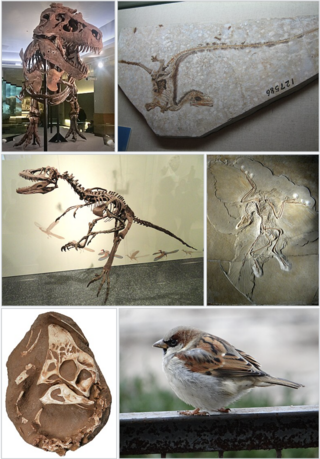
Coelurosauria is the clade containing all theropod dinosaurs more closely related to birds than to carnosaurs.
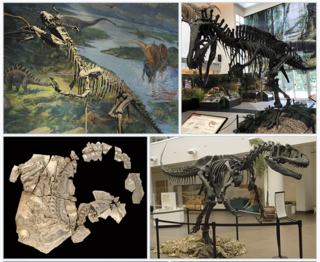
Carnosauria is an extinct group of carnivorous theropod dinosaurs that lived during the Jurassic and Cretaceous periods.
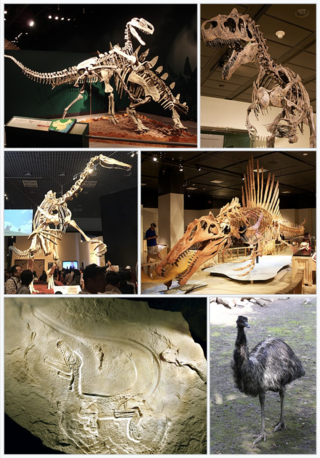
Tetanurae is a clade that includes most theropod dinosaurs, including megalosauroids, allosauroids, and coelurosaurs. Tetanurans are defined as all theropods more closely related to modern birds than to Ceratosaurus and contain the majority of predatory dinosaur diversity. Tetanurae likely diverged from its sister group, Ceratosauria, during the late Triassic. Tetanurae first appeared in the fossil record by the Early Jurassic about 190 mya and by the Middle Jurassic had become globally distributed.
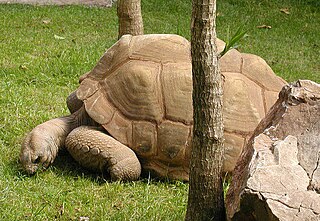
The Cryptodira are a suborder of Testudines that includes most living tortoises and turtles. Cryptodira differ from Pleurodira in that they lower their necks and pull the heads straight back into the shells, instead of folding their necks sideways along the body under the shells' marginals. They include among their species freshwater turtles, snapping turtles, tortoises, softshell turtles, and sea turtles.

Megalosauridae is a monophyletic family of carnivorous theropod dinosaurs within the group Megalosauroidea. Appearing in the Middle Jurassic, megalosaurids were among the first major radiation of large theropod dinosaurs. They were a relatively primitive group of basal tetanurans containing two main subfamilies, Megalosaurinae and Afrovenatorinae, along with the basal genus Eustreptospondylus, an unresolved taxon which differs from both subfamilies.

Megalosauroidea is a superfamily of tetanuran theropod dinosaurs that lived from the Middle Jurassic to the Late Cretaceous period. The group is defined as Megalosaurus bucklandii and all taxa sharing a more recent common ancestor with it than with Allosaurus fragilis or Passer domesticus. Members of the group include Spinosaurus, Megalosaurus, and Torvosaurus. They are possibly paraphyletic in nature with respect to Allosauroidea.

Metriacanthosauridae is an extinct family of allosauroid theropod dinosaurs that lived from the Middle Jurassic to the Early Cretaceous. The family is split into two subgroups: Metriacanthosaurinae, which includes dinosaurs closely related to Metriacanthosaurus, and another group composed of the close relatives of Yangchuanosaurus. Metriacanthosaurids are considered carnosaurs, belonging to the Allosauroidea superfamily. The group includes species of large range in body size. Of their physical traits, most notable are their neural spines. The records of the group are mostly confined to Asia, though Metriacanthosaurus is known from Europe. Metriacanthosauridae is used as a senior synonym of Sinraptoridae.
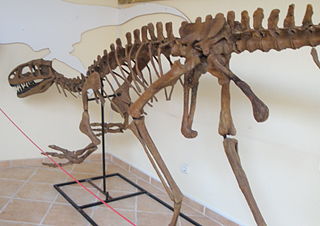
Lourinhanosaurus was a genus of carnivorous theropod dinosaur that lived during the Late Jurassic Period (Kimmeridgian/Tithonian) in Portugal. It is one of many large predators discovered at the Lourinhã Formation and probably competed with coeval Torvosaurus gurneyi, Allosaurus europaeus, and Ceratosaurus.

Trionychia is a superfamily of turtles which encompasses the species that are commonly referred to as softshelled turtles as well as some others. The group contains two families, Carettochelyidae, which has only one living species, the pig-nosed turtle native to New Guinea and Northern Australia, and Trionychidae, the softshelled turtles, containing numerous species native to Asia, North America and Africa. These families likely diverged during the late Jurassic. The oldest known stem-trionychian is Sinaspideretes from the Late Jurassic of China.

Australodocus is a genus of sauropod dinosaur that lived during the Late Jurassic period, around 150 million years ago, in what is now Lindi Region, Tanzania. Though initially considered a diplodocid, recent analyses suggest it may instead be a titanosauriform.

Paracryptodira is an extinct group of reptiles in the clade Testudinata, known from the Jurassic to Paleogene of North America and Europe. Initially treated as a suborder sister to Cryptodira, they were then thought to be a very primitive lineage inside the Cryptodira according to the most common use of the latter taxon. They are now often regarded as late-diverging stem-turtles, lying outside the clade formed by Cryptodira and Pleurodira. Paracryptodires are divided into three main groups, Compsemydidae, known from the Late Jurassic to Paleocene of North America and Europe, Pleurosternidae, known from the Late Jurassic to Early Cretaceous of North America and Europe, and Baenidae, known from the Early Cretaceous to Eocene of North America. The latter two groups are more closely related to each other than to Compsemys, forming the clade Baenoidea.
The Reuchenette Formation is a Jurassic geologic formation in Switzerland. It is Kimmeridgian in age and predominantly consists of well stratified limestone, with lithology variable both laterally and stratigraphically including wackestones, packstones and grainstones, as well as mudstone. Dinosaur remains are among the fossils that have been recovered from the formation, including the Turiasaurian sauropod Amanzia greppini, alongside a theropod tooth belonging to Ceratosauria indet, originally assigned to Megalosaurus meriani. teleosaurid crocodyliformes are also known, including Sericodon, Proexochokefalos and Machimosaurus. The metriorhynchid thalatosuchians Torvoneustes and Dakosaurus. The hybodontid shark Asteracanthus. The thalassochelydian turtle Thalassemys and Solnhofia is known from the formation, as is the platychelyid turtles Platychelys, and the plesiochelyid turtle Plesiochelys.
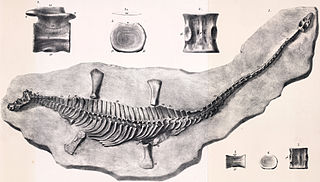
Microcleididae is an extinct family of basal plesiosauroid plesiosaurs from the Early Jurassic of France, Germany, Portugal and the United Kingdom. Currently, the oldest and the most known microcleidid is Eretmosaurus from the middle Sinemurian of the United Kingdom. Microcleididae was formally named and described by Roger B. J. Benson, Mark Evans and Patrick S. Druckenmiller in 2012.
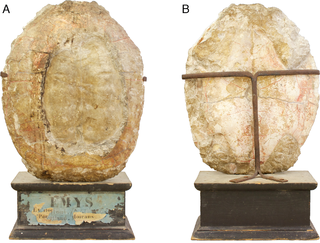
The Plesiochelyidae are an extinct family of turtles in the clade Thalassochelydia originally classified within the Cryptodira suborder, mostly belonging from the Jurassic period. An alternate study placed the clade Thalassochelydia in the Angolachelonia and outside the Testudines.
Hydropelta is a genus of Late Jurassic turtle from marine deposits in the Jura Mountains of eastern France.
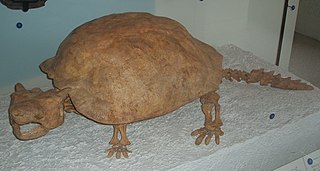
Perichelydia is a clade within Pantestudines known from the Middle Jurassic to Holocene. Alongside crown group Testudines, it also contains Helochelydridae, which is known from the Cretaceous of Europe and North America, Sichuanchelyidae from the Middle Jurassic to Paleocene of Asia and Europe, Meiolaniformes, which is known from the Cretaceous to Holocene of South America, Australia and Oceania, and Spoochelys, known from the Mid-Cretaceous Griman Creek Formation of Australia. Kallokibotion from the Late Cretaceous of Europe is also considered part of this group. Several other groups, including the proposed clade Angolachelonia, Paracryptodira, Macrobaenidae, Sinemydidae and Xinjiangchelyidae, which are sometimes considered members of Cryptodira, have also been found outside crown Testudines in several analyses. These groups are usually considered to be closer to the crown group than the other members of Perichelydia.

Thalassochelydia is a clade of extinct marine turtles from the Late Jurassic and earliest Cretaceous of Europe and South America. The group is defined as including Eurysternum, Plesiochelys and Thalassemys to the exclusion of Pelomedusa, Testudo and Protostega. While a clade uniting the families Eurysternidae, Plesiochelyidae and Thalassemydidae had been supported by phylogenetic evidence, a name was not given for the clade until 2017, when Jérémy Anquetin and colleagues coined Thalassochelydia.

Solnhofia is a genus of extinct thalassochelydian turtle from the Late Jurassic of Germany. The type species is Solnhofia parsonsi, named by Gaffney in 1975 for a partial skull and jaw from the early Tithonian of the Solnhofen Formation in Bavaria. Additional material including a complete skeleton is known from the late Kimmeridgian of Switzerland and the Kimmeridgian/Tithonian of other deposits within Bavaria, and potentially also unprepared material from the Late Jurassic of France. The genus was referred to the family Eurysternidae by Anquetin and colleagues in 2017, which may represent an artificial grade of early thalassochelydians. In 2020 a new species Solnhofia brachyrhyncha was described from the Kimmeridigan aged Reuchenette Formation of Switzerland.
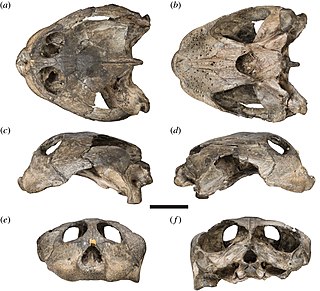
Sandownidae is a family of extinct marine turtles from the Cretaceous and Paleogene distributed around the Atlantic Ocean and adjacent areas. The family is defined as all taxa closer to the type genus Sandownia than to Pelomedusa, Testudo, Solnhofia, Eurysternum, Plesiochelys, Thalassemys or Protostega, a definition that encompasses the previous concept of the clade while also excluding it from being synonymous with other clades of modern or extinct marine turtles. Sandownidae may be within the larger clade Angolachelonia, defined as inclusive of Angolachelys and Solnhofia, sister to the entirely Late Jurassic marine group Thalassochelydia, although the concepts of the clades may shift with further phylogenetic analysis.

Compsemydidae is an extinct family of turtles, likely belonging to the clade Paracryptodira. The earliest undisputed member is Tongemys from the Berriasian age of the Early Cretaceous; two Late Jurassic genera have also sometimes been included in the group, but may alternatively be members of the family Pleurosternidae. The genus Compsemys survived the Cretaceous–Paleogene extinction event and lasted until the Thanetian age of the Paleocene.



















